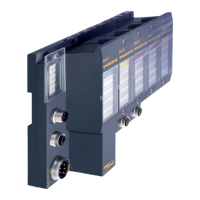D300529 0115 - BL67 I/O modules
15-17
Analog value representation (analog input modules)
Temperature- and resistance values (BL67-2AI-PT)
The hexadecimal/binary values for the negative value range cannot easily be converted into decimal
values, because the values are coded as two’s complement (→
page 15-9).
All numerical values from 000
hex
to 7FF
hex
represent positive values when coded as two’s complement.
Values in this range can easily be converted into decimal values. This is also relevant for binary numbers
in which the most significant bit (bit 16) is "0".
All numerical values from 800
hex
to FFF
hex
represent negative values when coded as two’s complement.
This is also relevant for binary numbers in which the most significant bit (bit 12) is "1".
The conversion into a decimal number is shown in the following:
→ Example of the conversion of negative numerical value, page 15-10.
The temperature values can now be calculated according to the parameterization.
The first equation is for the parameterization:
"Pt100, -200 … 850 °C"
"Ni100, -60 … 250 °C"
"Pt200, -200 … 850 °C"
"Pt500, -200 … 850 °C"
"Pt1000, -200 … 850 °C"
"Ni1000, -60 … 250 °C"
temperature value = 0,5 °C × decimal value
The value range:
-200 °C to -0,5°C
is displayed as follows:
E70
hex
to FFF
hex
(decimal: -400 to -1)
The value range:
0 °C to 850 °C
is displayed as follows:
000
hex
to 6A4
hex
(decimal: 0 to 1700)
The second equation is for the parameterization:
"Pt100, -200 … 150 °C"
"Ni100, -60 … 150 °C"
"Pt200, -200 … 150 °C"
"Pt500, -200 … 150 °C"
"Pt1000, -200 … 150 °C"
"Ni1000, -60 … 150 °C"
temperature value = 0,1 °C × decimal value

